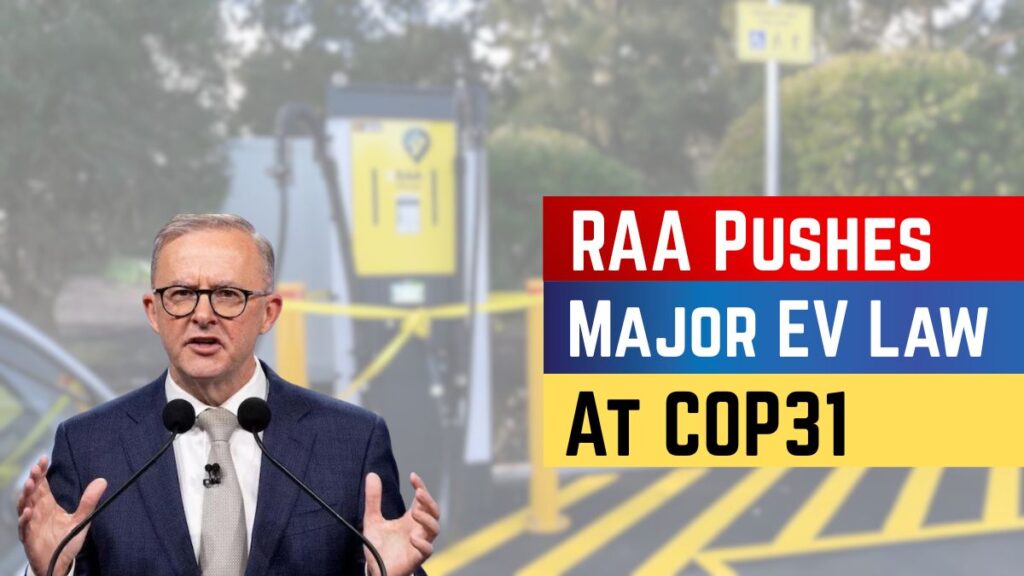EV Bi-Directional Charging – Australia is making headlines at COP31 with discussions around new electric vehicle (EV) rules that could reshape the nation’s clean energy future. The Royal Automobile Association (RAA) has been pushing for a mandatory bi-directional charging regulation, which would allow EVs not only to draw power but also feed electricity back into the grid. This concept, known as Vehicle-to-Grid (V2G) technology, could provide a major boost for renewable energy integration and household savings. With Australia’s EV adoption steadily rising, this potential mandate is drawing global attention and sparking debates over costs, infrastructure readiness, and consumer benefits.

RAA’s Push for Mandatory EV Charging Standards
The Royal Automobile Association (RAA) has highlighted that bi-directional charging could transform Australia’s energy system by turning EVs into mobile power stations. According to RAA, mandating this rule would help stabilize the grid, reduce household power bills, and maximize the value of renewable energy. At COP31, RAA representatives stressed that Australia cannot afford to lag behind countries like Japan and the UK, where V2G systems are already being tested widely. If introduced, this policy could also encourage car manufacturers to prioritize models equipped with bi-directional technology, ensuring Australian consumers are not left behind in the global EV shift.
COP31 Climate Summit: Australia’s EV Policy Spotlight
At COP31, Australia is under pressure to showcase stronger climate commitments, and bi-directional EV charging has become a centerpiece of discussions. Experts argue that widespread adoption could reduce the strain on coal-dependent power plants while helping meet Australia’s 2030 renewable energy targets. The government, however, faces challenges in balancing industry costs with public benefits. While supporters claim the mandate could accelerate the green transition, critics caution that upgrading infrastructure, including charging stations and grid systems, may require billions in investment. Still, the COP31 debate signals that Australia is considering ambitious steps to remain competitive in the clean energy race.
Benefits of Vehicle-to-Grid (V2G) for Australians
The proposed bi-directional EV rule offers significant advantages for everyday Australians. Households with EVs could use stored energy during peak demand hours, cutting electricity bills by hundreds of dollars annually. Communities vulnerable to power outages could also rely on EVs as backup energy sources. On a national scale, integrating V2G could reduce reliance on fossil fuels, support renewable storage, and strengthen energy security. Environmental groups emphasize that this move would align with Australia’s commitments under international climate agreements, while also creating new economic opportunities in renewable energy and EV manufacturing sectors across the country.
Challenges Ahead for EV Charging Mandates
Despite the promising potential, Australia faces obstacles in making bi-directional charging a nationwide standard. One major concern is the cost of upgrading home charging systems and public infrastructure to support V2G. Additionally, car manufacturers must ensure compatibility across different EV models, which may take years to standardize. Consumers may also be hesitant due to higher upfront costs, even if long-term savings are expected. Policymakers will need to balance incentives, subsidies, and regulations to ensure adoption is both fair and feasible. The outcome of these debates at COP31 will likely shape Australia’s EV and renewable energy future for decades.
FAQs
Q1: What is bi-directional EV charging?
It allows electric vehicles to both charge from and supply power back to the grid.
Q2: Why is RAA pushing this rule?
RAA believes it will cut household costs and stabilize Australia’s power grid.
Q3: What are the main challenges of this mandate?
High infrastructure costs, consumer hesitancy, and lack of EV compatibility.
Q4: How will this impact Australian households?
It could lower electricity bills and provide backup power during outages.




